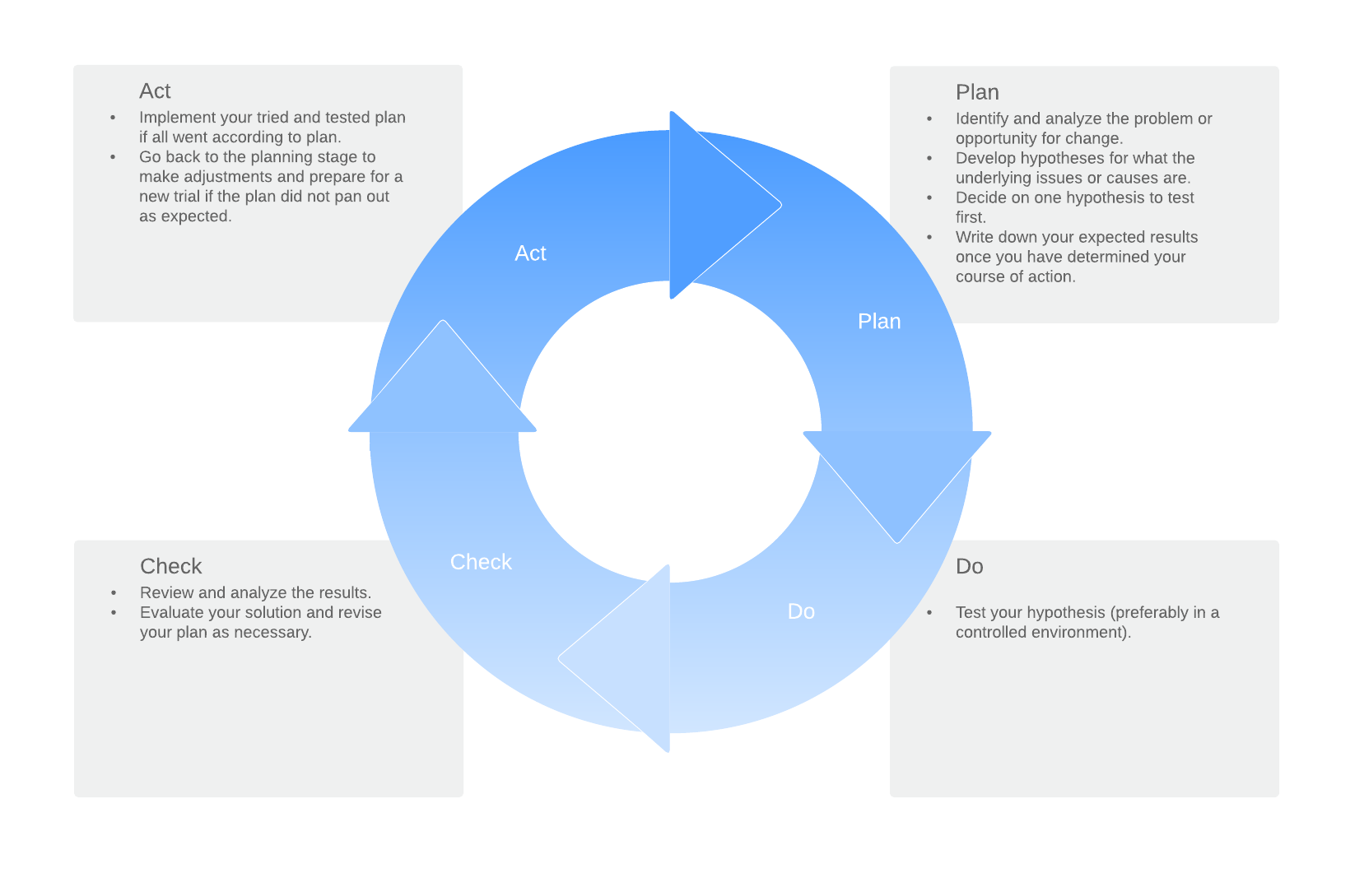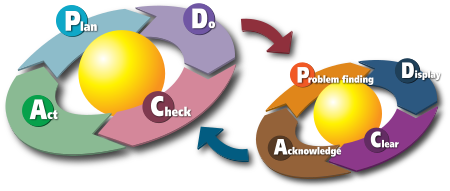What is PDCA & how to implement it?
What is PDCA?
The Plan-Do-Check-Act (PDCA) cycle, also known as the Deming wheel or the Deming cycle, is an iterative method for continual improvement of processes, products, or services and is a key element of lean management.
The PDCA model was developed in the 1950s by William Deming as a learning or improvement process based on the scientific method of problem-solving. Deming himself called it by another term—the Shewhart cycle—because he created the model based on an idea from his mentor, Walter Shewhart.
As all of these names suggest, the PDCA cycle is a loop rather than an end-to-end process. The goal is to improve on each improvement in an ongoing process of learning and growth.
Note:
In the 1950s, management consultant Dr William Edwards Deming developed a method of identifying why some products or processes don't work as hoped. His approach has since become a popular strategy tool, used by many different types of organizations. It allows them to formulate theories about what needs to change, and then test them in a "continuous feedback loop."
Deming himself used the concept of Plan-Do-Study-Act (PDSA). He found that the focus on Check is more about the implementation of a change.
He preferred to focus instead on studying the results of any innovations, and to keep looking back at the initial plan. He stressed that the search for new knowledge is always guided by a theory – so you should be as sure as you can that your theory is right!
How to apply the Plan-Do-Check-Act (PDCA)
Most organization want to improve. But when it comes to actually making needed changes, many fall short. Bureaucracy, silos, and even culture can block progress and stall innovation.
The Plan-Do-Check-Act cycle helps break organization out of stagnancy and transition to a system of continuous improvement. Learn how the PDCA cycle works and what benefits you can gain from using it at your company.
 |
What is PDCA?
The Plan-Do-Check-Act (PDCA) cycle, also known as the Deming wheel or the Deming cycle, is an iterative method for continual improvement of processes, products, or services and is a key element of lean management.
The PDCA model was developed in the 1950s by William Deming as a learning or improvement process based on the scientific method of problem-solving. Deming himself called it by another term—the Shewhart cycle—because he created the model based on an idea from his mentor, Walter Shewhart.
As all of these names suggest, the PDCA cycle is a loop rather than an end-to-end process. The goal is to improve on each improvement in an ongoing process of learning and growth.
When should you use the PDCA process?
The Plan-Do-Check-Act model is a helpful tool that can be used for a number of applications:
- Exploring and testing multiple solutions in a small, controlled trial
- Avoiding waste by catching and adapting ineffective solutions before rolling them out on a large scale
- Implementing change and continuous improvement
- Implementing Total Quality Management or Six Sigma initiatives
- Developing or improving a process
What is great about the PDCA cycle is that it can be applied across industries and organizational types.
Pros and cons of PDCA
The PDCA cycle has a number of advantages and disadvantages. Consider both before you decide to apply Plan-Do-Check-Act to different projects.
Pros
Versatile: You can use PDCA in a variety of business environments and for a number of applications. Potential use cases include project management, change management, product development, and resource management.
Simple and powerful: The PDCA model is simple and easy to understand, yet it is a powerful driver for meaningful change and improvement while minimizing waste and increasing efficiency.
Cons
Hard to do: Though the model is simple, the work isn’t easy. Because PDCA breaks process improvements into smaller steps, it can be slow and probably isn’t a great solution for urgent projects.
Requires commitment :
PDCA is not a one-time event. It is an ongoing, continuous process and therefore requires commitment and buy-in from the top down. Without committed leadership, the PDCA cycle can’t work effectively for the long term.
The PDCA Model
Learn the four stages in the PDCA cycle (which you can probably guess from the name) to start using it.
1. Plan
The planning stage is for mapping out what you are going to do to try to solve a problem or otherwise change a process. During this step, you will identify and analyze the problem or opportunity for change, develop hypotheses for what the underlying issues or causes are, and decide on one hypothesis to test first.
As you plan, consider the following questions:
- What is the core problem we need to solve?
- Is this the right problem to work on?
- What information do we need to fully understand the problem and its root cause?
- Is it feasible to solve it?
- What resources do we need?
- What resources do we have?
- What are some viable solutions?
- What are the measures of success?
- How will the results from a small trial translate to a full-scale implementation?
During this stage, an affinity diagram can help you and your colleagues organize a large number of ideas into groups. Once you have determined your course of action, write down your expected results. You will check your results against your hypothesis and expectations in the “Check” stage.
|
2. Do
The next step is to test your hypothesis (i.e., your proposed solution). The PDCA cycle focuses on smaller, incremental changes that help improve processes with minimal disruption.
Test your hypothesis with a small-scale project, preferably in a controlled environment, so you can evaluate the results without interrupting the rest of your operation. You might want to test the solution on one team or within a certain demographic.
3. Check
Once you have completed your trial, it’s time to review and analyze the results. This stage is important because it allows you to evaluate your solution and revise your plans as necessary. Did the plan actually work? If so, were there any hiccups in the process? What steps could be improved or need to be eliminated from future iterations?
Your evaluation at this stage will guide your decisions in the next step, so it is important to consider your results carefully.
4. Act
Finally, it is time to act. If all went according to plan, you can now implement your tried-and-tested plan. This new process now becomes your baseline for future PDCA iterations.
Consider the following questions before you act:
- What resources do you need to implement the solution at full scale?
- What training is needed for successful implementation and adoption?
- How can you measure and track the performance of the solution?
- What opportunities are there for improvement?
- What have we learned that can be applied to other projects?
If the plan did not pan out as expected, you can cycle back to the planning stage to make adjustments and prepare for a new trial.

How to Use PDCA in Your Life
While PDCA/PDSA is an effective business tool, you can also use it to improve your own performance:
First, Plan: Identify what's holding you back personally, and how you want to progress. Look at the root causes of any issues, and set goals to overcome these obstacles.
Next, Do: When you've decided on your course of action, safely test different ways of getting the results that you want.
Then, Check: Review your progress regularly, adjust your behavior accordingly, and consider the consequences of your actions.
Finally, Act: Implement what's working, continually refine what isn't, and carry on the cycle of continuous improvement.
Key Points :
The PDCA/PDSA cycle is a continuous loop of planning, doing, checking (or studying), and acting. It provides a simple and effective approach for solving problems and managing change. The model is useful for testing improvement measures on a small scale before updating procedures and working practices.
The approach begins with a Planning phase in which problems are clearly identified and understood, and a theory for improvement is defined. Potential solutions are tested on a small scale in the Do phase, and the outcome is then studied and Checked.
Go through the Do and Check stages as many times as necessary before the full, polished solution is implemented, in the Act phase of the cycle.
Supporting Kaizen with the PDCA Cycle
The PDCA cycle is a particularly useful tool for organization who follow the Kaizen method. Kaizen is an organizational mindset and culture focused on small, frequent changes that lead to significant improvements over time.
The PDCA cycle supports the Kaizen philosophy by providing the framework for developing and implementing continuous improvements.

Source :
PPD Manjung




Comments
Post a Comment
Sebarang cadangan dialu-alukan.